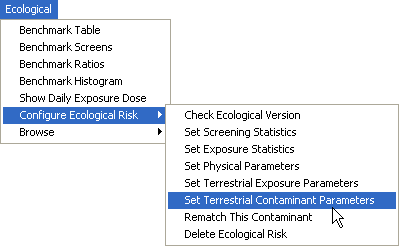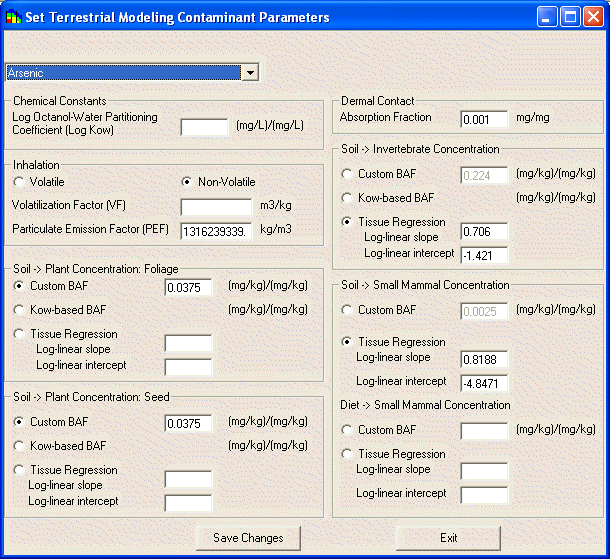
Many of the parameters used in modeling dose to wildlife receptors are chemical-specific rather than species-specific. For species-specific parameters, see Set Terrestrial Exposure Parameters. Custom values for contaminant-specific parameters can be entered in the Set Terrestrial Modeling Contaminant Parameters Window. These parameters are used in modeling dose to each receptor from selected pathways.
To view (and change if desired) current contaminant-specific exposure parameters, from the Ecological menu, select Configure Ecological Risk, and Set Terrestrial Modeling Contaminant Parameters.

In the resulting window, select an analyte from the drop down list.

To change a parameter value, click on the box corresponding to that parameter, and enter the value. When you’ve finished modifying the parameters for the species, click the Save Changes button, and the changes will be saved to your SADA file. Otherwise, changes will not be saved.
It is very important to use the appropriate units for all parameters.
Log Octanol-Water Partitioning Coefficient (log Kow)
The octanol-water partition coefficient (Kow) is a measure of the equilibrium concentration of a compound between octanol and water that indicates the potential for partitioning into soil organic matter (i.e., a high Kow indicates a compound which will preferentially partition into soil organic matter rather than water). Kow is inversely related to the solubility of a compound in water. Log Kow is used in models to estimate plant and soil invertebrate bioaccumulation factors.
Inhalation Parameters
Inhalation exposures occur when a chemical volatized from soil is inhaled as a vapor or when soil particles containing the chemical are respired. Two parameters are needed to estimate chemical concentrations in air to determine dose from inhalation exposures: the Volatilization Factor (VF) and the Particulate Emission Factor (PEF).
Volatilization Factor
The Volatilization Factor (VF), in m3/kg, is a measure of the tendency of a chemical to volatize from soil to vapor. Volatile Organic Compounds (VOC) are defined by USEPA (1998) as chemicals with Henry’s Law constants greater than 10-5 atm-m3 /mol and molecular weights less than 200 grams/mol.
Particulate Emission Factor
The Particulate Emission Factor (PEF), expressed in kg soil/m3 air, is a measure of the amount of respirable soil particles in a volume of air. It is used to estimate chemical concentrations in air from concentrations in soil.
Soil-to-Plant Concentration
Modeling ingestion exposures for herbivorous wildlife receptors requires information on chemical concentrations in plant tissues. Chemical concentrations in plant tissues are calculated from soil concentrations using point estimates of soil-to-plant bioaccumulation factors (BAF), estimated bioaccumulation factors based on octanol-water partitioning coefficients (for nonionic organic analytes), or soil-to-plant tissue regression relationships. Regression relationships are the preferred means of calculating plant concentrations. SADA Version 3 separates plant tissues into two types: foliage and seeds. In many cases, current default settings assume seed and foliage uptake are similar since soil-to-foliage values are more generally available.
Default point estimates appear as Custom BAFs. Users can modify these values if they have site-specific values or prefer values from a source other than that used to derive default values for SADA.
Kow-based soil-to-plant BAFs were generated using the following equation from EPA (2000):
![]()
where BAFplant = soil to plant foliage bioaccumulation factor (![]() )
)
Kow = octanol-water partitioning coefficient.
Soil-to-plant tissue regression relationships are of the form:
![]()
where Ctissue = Chemical concentration in plant tissue (mg/kg, dry weight)
C soil = Chemical concentration in dry soil (mg/kg)
Slope = coefficient for slope of the regression model
Intercept = value for the y-intercept of the regression model.
Dermal Contact Parameters
Absorption factor
The absorption factor for dermal contact is a ratio of the amount of chemical in contact with the skin that is actually absorbed into the body.
Soil-to-Invertebrate Concentration
Modeling ingestion exposures for insectivorous wildlife receptors requires information on chemical concentrations in invertebrate tissues. Chemical concentrations in invertebrate tissues are calculated from soil concentrations using point estimates of soil-to-invertebrate bioaccumulation factors (BAF), estimated bioaccumulation factors based on octanol-water partitioning coefficients (for nonionic organic analytes), or soil-to-invertebrate tissue regression relationships. Regression relationships are the preferred means of calculating invertebrate concentrations.
Default point estimates appear as Custom BAFs. Default are largely based on data for earthworms. Earthworms live in direct contact with soil, process large amounts of soil through their bodies, and are assumed to be on the high end of bioaccumulation by invertebrates. Users can modify these values if they have site-specific values or prefer values from a source other than that used to derive default values for SADA.
Kow-based soil-to-invertebrate BAFs were generated using the following equation from EPA (2000):
![]()
where BAFworm = soil to earthworm bioaccumulation factor (![]() )
)
foc = fraction organic carbon in soil. Default is set to 1%.
Kow = octanol-water partitioning coefficient.
Soil-to-invertebrate tissue regression relationships are of the form:
![]()
where Ctissue = Chemical concentration in invertebrate tissue (mg/kg, dry weight)
C soil = Chemical concentration in dry soil (mg/kg)
Slope = coefficient for slope of the regression model
Intercept = value for the y-intercept of the regression model.
Soil-to-Small Mammal Concentration
Modeling ingestion exposures for carnivorous wildlife receptors requires information on chemical concentrations in vertebrate prey. Chemical concentrations in vertebrate prey are calculated from soil concentrations using point estimates of soil-to-vertebrate bioaccumulation factors (BAF) or soil-to-vertebrate tissue regression relationships. Regression relationships are the preferred means of calculating mammalian prey concentrations. When soil-to-tissue relationships are unavailable, it may be necessary to use diet-to-tissue bioaccumulation factors. In SADA, the simplifying assumption that carnivores eat small mammals has been made. This is because bioaccumulation factors for mammals are available for a wide range of chemicals whereas they are often lacking for birds and other vertebrates. Therefore, SADA refers to Fraction Mammal in the diet and Soil-to-Small Mammal BAFs.
Default Soil-to-Small Mammal point estimates appear as Custom BAFs. Defaults are largely based on data compiled by Sample et al. (1998) or EPA (2003). Users can modify these values if they have site-specific values or prefer values from a source other than that used to derive default values for SADA.
Kow-based soil-to-vertebrate or diet-to-vertebrate BAFs are not provided in SADA Version 3 based upon recommendations in EPA (2003).
Soil-to-vertebrate tissue regression relationships are of the form:
![]()
where Ctissue = Chemical concentration in vertebrate tissue (mg/kg, dry weight)
C soil = Chemical concentration in dry soil (mg/kg)
Slope = coefficient for slope of the regression model
Intercept = value for the y-intercept of the regression model.
Diet-to-Small Mammal Concentration
When Soil-to-Small Mammal relationships are unavailable, chemical concentrations in vertebrate prey of carnivorous wildlife may be estimated from Diet-to-Small Mammal BAFs. Unlike soil-to-tissue BAFs where the BAF is multiplied by the soil concentration to arrive at the tissue concentration, diet-to-tissue BAFs are multiplied by the chemical concentration in the prey animal’s diet to determine the tissue concentration. Thus, it’s necessary to estimate the chemical concentration in the prey animal’s diet. SADA does this using dietary information specified for Mammalian Prey Diet at the Set Terrestrial Exposure Parameters screen.
Default Diet-to-Small Mammal point estimates appear as Custom BAFs. Defaults are largely based on studies of uptake into beef. When necessary, they were converted from transfer factors in d/kg to BAFs in mg/kg tissue per mg/kg dry food by multiplying the transfer factor by the dry food ingestion rate for beef cows. Users can modify these values if they have site-specific values or prefer values from a source other than that used to derive default values for SADA.
No Diet-to-Tissue regression relationships have been included in SADA, but users who have developed their own relationships may enter the slope and intercept values under Diet-to-Small Mammal Concentration, Tissue Regression if the Diet-to-vertebrate tissue regression relationship is of the form:
![]()
where Ctissue = Chemical concentration in vertebrate tissue (mg/kg, dry weight)
Cdiet = Chemical concentration in diet (mg/kg, dry weight)
Slope = coefficient for slope of the regression model
Intercept = value for the y-intercept of the regression model.